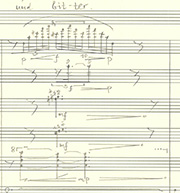A text by Alain Claude Sulzer that explores human beings’ fear of dying forms the basis of Andrea Lorenzo Scartazzini's “Dies illa” for choir and orchestra. The world premiere is scheduled for November 2023 in Basel.
The Basler Gesangverein (Basel Choral Society) is one of Switzerland’s oldest mixed concert choirs. To mark its 200th anniversary, the Gesangsverein commissioned Andrea Lorenzo Scartazzini to write a symphonic work for the choir. The planned programme will also feature “A German Requiem” by Johannes Brahms, who wrote his requiem not as a liturgical work commemorating the dead in the tradition of a particular confession, but as a consolation for the bereaved, as a “beatitude for those who suffer”. Brahms set out the texts (extracts taken from the Bible) in such a way that they lead us from sorrow and grief to comfort. In his Dies illa, Scartazzini alludes to the second movement of Brahms’ “Requiem”, “Denn alles Fleisch, es ist wie Gras” (“For all flesh, it is as grass”) – a piece containing none of the visions of terror or pleas for the salvation of the deceased that are normally present in the traditional requiem’s second movement, the “Dies irae”. Instead, Scartazzini sees Brahms’s piece, which has always captivated him, as a “well-nigh baroque memento mori”. Alain Claude Sulzer, the Swiss author who wrote the words for “Dies illa” at the composer’s suggestion, nevertheless chose to base his text on a vision of terror: death. There are no depictions of the torments awaiting in the beyond, no religious fantasies of hell or punishment; rather, as the composer states, the piece is completely concerned with “the proverbial ‘mortal fear’, the moment of death that awaits us all and that we repress as best we can throughout our lives.” Five stanzas portray the moment of dying from different angles. The metaphors of Brahms’s texts are heightened and exaggerated: “The landscape of death in Dies illa is a desert.” What remains are “silence”, “emptiness”, “transience” and “an abyss”. For Scartazzini, the text is “already musical in itself”; sometimes he follows the form, sometimes he diverges from it. He adopts the text’s five-part structure and creates musical links between the stanzas. His music aims to “call to mind motifs of the traditional ‘Dies irae’”. It develops in several waves “from silence” to “threatening vehemence”. The composer describes his work, which explores “existential matters”, as “sensual, doleful and emotional”. Scartazzini loves working with texts, as evidenced not only by his operas, the song cycle “So sieht's aus” based on poems by Nora Gomringer, and numerous other vocal works, but also by “Viaggiatori” (2011), his first work for choir and symphony orchestra, which sets texts by Hugo von Hofmannsthal, Adolf Wölfli, Dante Alighieri and Friedrich Hölderlin. Then, as now, the commissions were special in that Scartazzini was required to write for an experienced amateur choir, to make the choral part demanding but singable. At the same time, the orchestra on the one hand needs to “support” the choir, but on the other hand is able to go far beyond the choral parts in terms of harmony and structure. “Shaping these simpler and more complex layers into a successful whole” was a challenge the composer was happy to meet.
Robert Krampe
(for “[t]akte” 2023)



